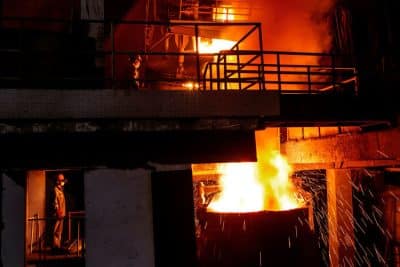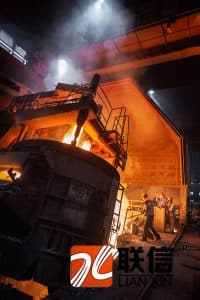Which refractory materials and refractory bricks to choose for a copper smelting kiln is often a big problem that bothers people. Choosing kiln refractory materials and refractory bricks usually requires comprehensive consideration of factors such as working conditions, temperature, atmosphere, and economic costs.
Magnesia-chromium refractory materials: Magnesium-chromium refractory materials are made of magnesia and chromite as the main raw materials. They have good high temperature resistance, strong thermal stability and slag corrosion resistance. Among them, the increase in Cr₂O₃ content can further improve its resistance to slag erosion. However, since hexavalent chromium is harmful to the environment and human health, the alkaline medium and oxygen partial pressure need to be strictly controlled during the production and production process.
Directly bonded magnesia-chromium bricks and rebonded magnesia-chromium bricks: these two types of magnesia-chromium bricks are commonly used in Noranda furnaces, for example. They have high fire resistance and high temperature performance. When building masonry, attention should be paid to strictly following the design requirements, such as taking moisture-proof measures, controlling the size of brick joints, and correctly setting expansion joints.

copper smelting kilns
High alumina refractory bricks: Its mineral composition includes corundum, mullite and glass. High alumina refractory bricks have higher alumina content and have better fire resistance and mechanical strength. It can be produced by the sintering method, and also has various forms such as fused cast bricks, fused granular bricks, unfired bricks and unshaped bricks. High alumina refractory bricks are widely used in high-temperature industrial kilns in the steel industry, non-ferrous metal industry, etc.
other materials:
– Silica bricks: have the advantages of high thermal conductivity, high softening point under load, and strong resistance to acidic slag erosion, but have low thermal shock resistance. They are mainly used as structural materials for coke ovens, glass furnaces, etc.
– Clay bricks: composed of mullite, glass phase and cristobalite. They are made by pre-calcining clinker with hard clay as raw material, then adding soft clay through a certain process. Commonly used in blast furnaces, hot blast furnaces and other kilns.
– Dolomite brick: It is an alkaline refractory material. It uses dolomite as the main raw material. It has good high temperature stability and strong slag resistance to alkaline slag. It is often used in alkaline converters, etc., and can also be used in certain The lining of some refining bags outside the furnace.
– Forsterite refractory bricks: With forsterite 2MgO·SiO₂ as the main component, it can be used as checker bricks in open-hearth furnace regenerators, bricks for ingots, heating furnace bottoms, etc. It also has good results in copper-smelting furnaces.

copper smelting kilns
In addition, there are some carbon-containing refractory materials such as carbon bricks, graphite refractory products, silicon carbide refractory products, etc., which also have their own characteristics and scope of application. In practical applications, in order to achieve better results and extend the service life of the kiln, a variety of refractory materials are often selected for use according to the working conditions and requirements of different parts. At the same time, the quality of refractory materials must be ensured, and masonry and maintenance must be carried out in strict accordance with construction specifications.
If you have relevant needs for refractory bricks and refractory materials, you can contact us to customize a kiln construction plan that suits you.
Mob/whatsapp: +8615838386016
email: zzlx@lxrefractory.com
